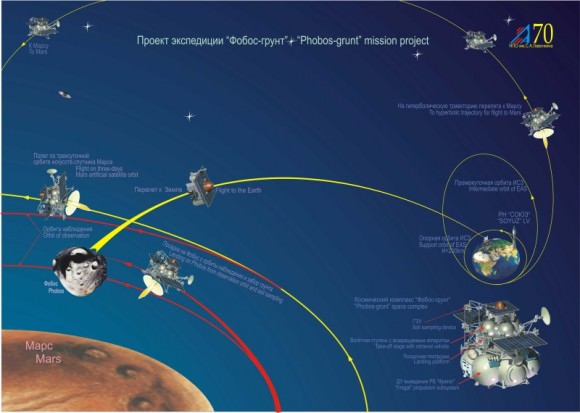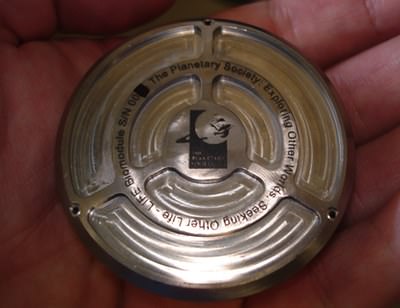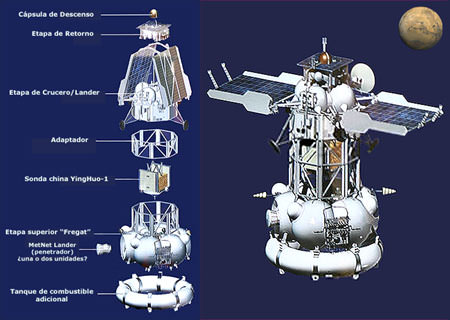[/caption]
Editor’s note: Dr. David Warmflash, principal science lead for the US team from the LIFE experiment on board the Phobos-Grunt spacecraft, provides an update for Universe Today on the likelihood of saving the mission.
Although the launch window for a round-trip to Mars closed yesterday (November 21, 2011) with Russia’s Phobos-Grunt probe still circling in low Earth orbit, a one-way flight to the Red Planet will be possible for another few weeks. As Russian engineers frantically try to contact the silent probe, scientists from the Yinghuo-1 and LIFE experiments are holding out hope that they could still complete their missions, or a perhaps even a modified version of their experiments.
Launched November 9 to collect a surface sample from the larger of Mars’ two moons, Phobos, the 13-ton spacecraft was to be boosted from its initial parking orbit low in Earth’s skies within hours after reaching space, when the engine of its Fregat upper stage failed to ignite. Thought to have reverted to safe mode, Phobos-Grunt has been flying straight and periodically adjusting her orbit using small thruster engines. While this maneuvering has extended the amount of time that the probe can remain in space before reentering Earth’s atmosphere, ground controllers have been struggling to establish a communication link.

Had the malfunction occurred just one step further into the flight –after a first burn of the Fregat was to raise the apogee (the highest point) of the spacecraft’s orbit to an altitude of about 4,170 kilometers– the timing and geometry between Earth-bound transmitters and the spacecrafts antennae would have made signaling the craft a straight forward task. But with Grunt orbiting much lower (thus moving much faster with respect to the ground), and with an antenna that could receive the signal obstructed partially by a fuel tank that was to be jettisoned after the first Fregat burn, controllers have only a couple of minutes at a time to attempt communication. Since the spacecraft was not designed for this scenario, getting her attention may be depend on prospect of getting the signals toward her at some unlikely angle. In other words, restoring control over Phobos-Grunt may be a matter of luck.
But if luck is a factor in recovering the spacecraft, then the extension of her expected time in orbit due to thruster firings may prove helpful. The more time that controllers have to attempt contact, the better the chances that they’ll get lucky at some point before the craft reenters the atmosphere.
If this should happen, however, where should the probe travel? As of yesterday, it no longer will be able to go Mars, land on the surface of Phobos, scoop a 200 gram sample into the specially-designed return capsule, and still have a window for the capsule to be launched on a trajectory back to Earth. Last week, a lunar mission was discussed as a possibility.
But as a story released yesterday by the Russian news service Ria Novosti notes, the launch window to Mars for a craft that does not need to return to Earth remains open. In the case of NASA’s Mars Science Laboratory with its rover “Curiosity,” for example, the launch window to Mars is open until December 18.
This means that –if communication with Grunt is established– the Phobos-Grunt could be launched on a trajectory to Mars. This would not support the objective of return a sample from the Phobosian surface. However, since China’s Yinghuo-1 probe is piggybacked on the spacecraft for delivery into orbit around Mars, its mission at least would not be affected by the lack of a return flight.

Then, there is the Planetary Society’s Phobos-LIFE. The objective of this project is to study the effects of the interplanetary environment on various organisms during a long duration flight in space beyond the Van Allen Radiation Belts, which protect organisms in low Earth orbit from some of the most powerful components of space radiation. If the biomodule containing the LIFE organisms travels one way to Mars, it will not help the experiment. But it may be possible to jettison the return capsule when the spacecraft is in a high orbit around Earth, before the final burn sending it toward Mars has been completed. If this happens, the return capsule –which would not be needed anyway for a one-way Mars mission– might be set on a trajectory that takes it beyond the Van Allen belts for many months, or longer, but that eventually takes it back to Earth. If so –and as usual, I emphasize the “IF” – the capsule could make the reentry and landing that it was designed to do, we could recover our biomodule and study the organisms as planned.


why cant signal be relayed by other satellite?
Although my knowledge of this topic is pretty small here’s my understanding…
Because Phobos-Grunt is in a fairly low orbit it’s moving across the sky very quickly. According to russianspaceweb.com this issue presented itself once they realized there was a problem. The antennae set up to communicate with the satellite simply couldn’t track fast enough to keep it in the signal beam. The same problem would likely affect any satellite in low earth orbit trying to communicate with Phobos-Grunt. The window would be so short that nothing useful could be transmitted.
Could they send signals from a satellite higher up, say in geosynchronous orbit? I don’t know. Is this something a communications satellite can even attempt? Is Phobos-Grunt listening on the same frequencies that those satellites are able to send on? Is Phobos-Grunt’s antenna oriented correctly to receive those signals?
Yes and what about ISS? too low? How about any craft visiting ISS – could they make a quick detour to a reasonable close (but safe) distance to GRUNT to relay signals??
Brilliant idea for the LIFE experiment though i not gonna think it will happen. This way the contamination risk of Mars in case of a failure in (Martian-)orbit is null. Also the Phobos-station could still be landed and do some basic recon of Phobos and Mars with its on-board instrumentation at least. Fingers still crossed!
I saw an idea to send the craft to a asteroid sample and return.
This is what happens when you do things ‘on the cheap’. It’s no wonder most of their Mars missions have failed.
What about possibility to wait on Phobos with lander for next year return window? Current geometry will not allow return, but after one martian year things can be more optimistics. Don’t know power source of lander if it is capable of something like that.
ESA has made contact with the craft!
ESA reports that they got contact with Phobos-Grunt: http://www.esa.int/esaCP/index.html
What’s the possibility of using the ISS to transmit a signal to the craft?